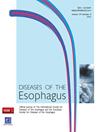14. IMPACTS OF ADDITIONAL CYCLES OF NEOADJUVANT IMMUNOCHEMOTHERAPY ON ESOPHAGECTOMY IN ESOPHAGEAL SQUAMOUS CELL CARCINOMA
IF 2.3
3区 医学
Q3 GASTROENTEROLOGY & HEPATOLOGY
引用次数: 0
Abstract
The aim of this study is to explore the pathological characteristics and safety of esophagectomy after different cycles of neoadjuvant immunochemotherapy for esophageal squamous cell carcinoma (ESCC). We prospectively collected patients who underwent neoadjuvant immunochemotherapy combined with esophagectomy from two institutes between 2019 and 2022. The primary outcome was defined as pathological complete response (PCR), and the secondary outcomes were defined as the incidence of postoperative complications. The most commonly used checkpoint inhibitor was camrelizumab. A total of 152 enrolled patients underwent esophagectomy, with 9 of 119 patients (7.6%) in the 2-cycle group undergoing thoracotomy and 2 patients of 33 patients (6.1%) in the >2-cycle group converting to thoracotomy. Twenty-three patients in the 2-cycle group and 6 patients in the >2-cycle group achieved PCR, there was no statistically significant difference between the two groups (19.3% vs. 18.2%; P = 0.882). The N0 rate (57.1% vs. 51.5%; P = 0.565) and lymph node ratio (6% vs. 6%; P = 0.489) were similar between the two groups. The most common postoperative complication was pneumonia, there were no significant differences in postoperative complications between the two groups. This study indicated that although additional cycles of neoadjuvant immunochemotherapy had no significant effect on the feasibility and safety of esophagectomy, 2-cycle of treatment is enough when considering pathological complete response rate.14.新辅助免疫化疗对食管鳞状细胞癌食管切除术的影响
本研究的目的是探讨食管鳞状细胞癌(ESCC)新辅助免疫化疗不同周期后食管切除术的病理特征和安全性。我们前瞻性地收集了2019年至2022年间来自两个研究所的接受新辅助免疫化疗联合食管切除术的患者。主要结果定义为病理完全反应(PCR),次要结果定义为术后并发症的发生率。最常用的检查点抑制剂是卡雷珠单抗。共有152名入选患者接受了食管切除术,其中2周期组119名患者中有9名(7.6%)接受了开胸手术,>2周期组33名患者中的2名(6.1%)改为开胸手术。2周期组23例患者和>2周期组6例患者实现了PCR,两组之间没有统计学显著差异(19.3%对18.2%;P = N0发生率(57.1%对51.5%;P = 0.565)和淋巴结比率(6%对6%;P = 0.489)在两组之间相似。最常见的术后并发症是肺炎,两组术后并发症无显著差异。本研究表明,尽管新辅助免疫化疗的额外周期对食管切除术的可行性和安全性没有显著影响,但考虑到病理完全缓解率,2个周期的治疗就足够了。
本文章由计算机程序翻译,如有差异,请以英文原文为准。
求助全文
约1分钟内获得全文
求助全文
来源期刊

Diseases of the Esophagus
医学-胃肠肝病学
CiteScore
5.30
自引率
7.70%
发文量
568
审稿时长
6 months
期刊介绍:
Diseases of the Esophagus covers all aspects of the esophagus - etiology, investigation and diagnosis, and both medical and surgical treatment.
 求助内容:
求助内容: 应助结果提醒方式:
应助结果提醒方式:


